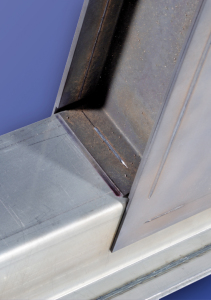 Ultra-high-strength chromium steels, due to their high carbon content, could not be reliably bonded together by laser until now. At this year’s EuroBLECH, the International Sheet Metal Working Technology Exhibition, the Fraunhofer Institute for Laser Technology ILT will use a B-pillar to show how laser welding can be reliably used on press-hardened, martensitic chromium steels.
Ultra-high-strength chromium steels, due to their high carbon content, could not be reliably bonded together by laser until now. At this year’s EuroBLECH, the International Sheet Metal Working Technology Exhibition, the Fraunhofer Institute for Laser Technology ILT will use a B-pillar to show how laser welding can be reliably used on press-hardened, martensitic chromium steels.
At EuroBLECH 2014, Fraunhofer ILT will use a test specimen for B-pillars to demonstrate that laser welding can be used reliably on press-hardened, martensitic chromium steels.
Within the scope of the research project SECOMAL, the Fraunhofer Institute for Laser Technology ILT in Aachen has determined process parameters and process windows for the laser welding of three ultra-high-strength chromium steels: pure ferritic, ferritic-martensitic, and pure martensitic with carbon content ranging from 0.02 to 0.46 mass percent. Hardened, they achieve a tensile strength of up to two gigapascals with fracture strain of 10 percent. Their inherent resistance to corrosion makes these steels ideal for vehicle manufacturing.
The materials with the lowest and the highest carbon content – ferritic and martensitic chromium steels, respectively – can now be easily joined, even when the materials are hardened. “Only the martensitic stainless grade 1.4021, with an average carbon content of 0.21 percent poses dfficulties,” says Dipl.-Ing. Martin Dahmen, a researcher of the Fraunhofer ILT.
According to the textbook, preheating martensitic steel is recommended before joining and then tempering it – that is, heating the welding zone locally – to improve the toughness in the heat-affected zone. Hardened sheets can be tempered up to 450°C without causing any loss of quality. In principle, all types of laser beams are suitable for welding materials, but since the laser should produce parallel seam edges, Dahmen recommends using only the so-called brilliant beam sources and CO2 lasers.
But how does the laser compare to metal active gas (MAG) welding? “With judicious heat treatment, the hardened chromium steel can be joined without difficulty, with the exception of 1.4021,” says the ILT researcher. “On the other hand, MAG welding is problematic because of the resulting high-energy input in the joining areas, even with appropriate heat treatment.”
What successful laser welding looks like in practice will be showcased by the Fraunhofer ILT on its test specimen of a B-pillar of ultra-high-strength steel welded to a vehicle rocker panel. “This proves that welding ultra-high-strength materials by laser offers a viable alternative to manganese-boron steels,” says Dahmen. Visitors to EuroBLECH 2014 can visit the demonstrator exhibit and learn more about laser welding chromium steels and other Fraunhofer ILT projects at the Fraunhofer Joint Stand in Hall 11, Booth C05.



